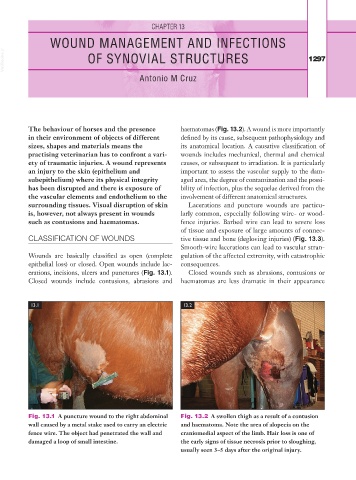Page 1322 - Equine Clinical Medicine, Surgery and Reproduction, 2nd Edition
P. 1322
CHAPTER 13
WOUND MANAGEMENT AND INFECTIONS
VetBooks.ir OF SYNOVIAL STRUCTURES 1297
Antonio M Cruz
The behaviour of horses and the presence haematomas (Fig. 13.2). A wound is more importantly
in their environment of objects of different defined by its cause, subsequent pathophysiology and
sizes, shapes and materials means the its anatomical location. A causative classification of
practising veterinarian has to confront a vari- wounds includes mechanical, thermal and chemical
ety of traumatic injuries. A wound represents causes, or subsequent to irradiation. It is particularly
an injury to the skin (epithelium and important to assess the vascular supply to the dam-
subepithelium) where its physical integrity aged area, the degree of contamination and the possi-
has been disrupted and there is exposure of bility of infection, plus the sequelae derived from the
the vascular elements and endothelium to the involvement of different anatomical structures.
surrounding tissues. Visual disruption of skin Lacerations and puncture wounds are particu-
is, however, not always present in wounds larly common, especially following wire- or wood-
such as contusions and haematomas. fence injuries. Barbed wire can lead to severe loss
of tissue and exposure of large amounts of connec-
CLASSIFICATION OF WOUNDS tive tissue and bone (degloving injuries) (Fig. 13.3).
Smooth-wire lacerations can lead to vascular stran-
Wounds are basically classified as open (complete gulation of the affected extremity, with catastrophic
epithelial loss) or closed. Open wounds include lac- consequences.
erations, incisions, ulcers and punctures (Fig. 13.1). Closed wounds such as abrasions, contusions or
Closed wounds include contusions, abrasions and haematomas are less dramatic in their appearance
13.1 13.2
Fig. 13.1 A puncture wound to the right abdominal Fig. 13.2 A swollen thigh as a result of a contusion
wall caused by a metal stake used to carry an electric and haematoma. Note the area of alopecia on the
fence wire. The object had penetrated the wall and craniomedial aspect of the limb. Hair loss is one of
damaged a loop of small intestine. the early signs of tissue necrosis prior to sloughing,
usually seen 3–5 days after the original injury.

